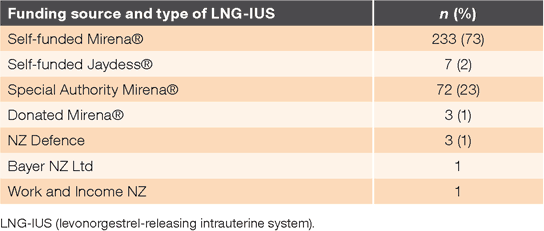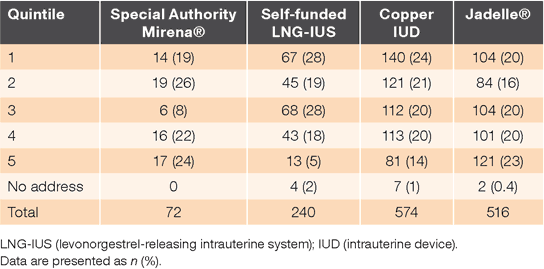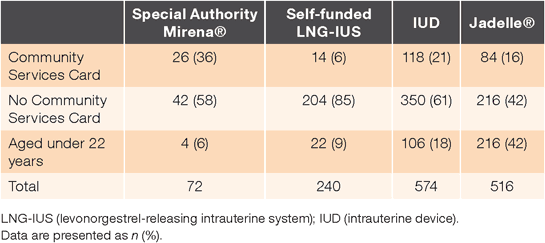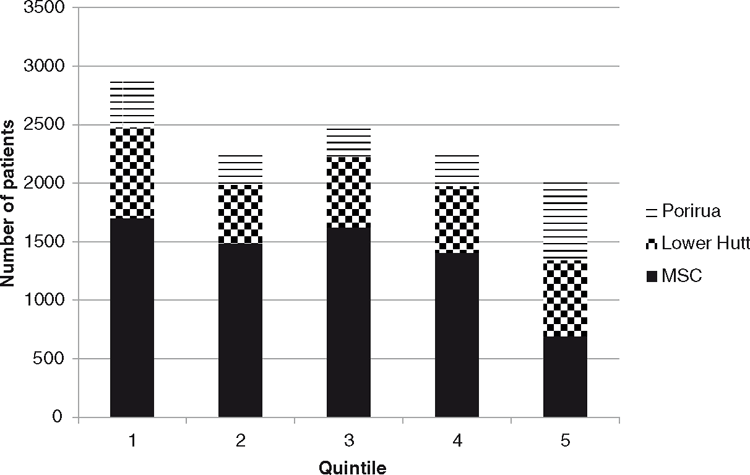Who can afford a Mirena® for contraception?
Catriona Murray 1 , Christine Roke 11 New Zealand Family Planning, PO Box 11515, Wellington 6142, New Zealand
Correspondence to: Catriona Murray, New Zealand Family Planning, Margaret Sparrow Clinic, PO Box 24 164, Wellington 6011, New Zealand. Email: catriona.murray@familyplanning.org.nz
Journal of Primary Health Care 10(3) 201-206 https://doi.org/10.1071/HC18024
Published: 28 August 2018
Journal Compilation © Royal New Zealand College of General Practitioners 2018.
This is an open access article licensed under a Creative Commons Attribution-NonCommercial-NoDerivatives 4.0 International License.
Abstract
INTRODUCTION: The Mirena®, a levonorgestrel-releasing intrauterine system (LNG-IUS), is an effective form of contraception that lasts for 5 years. In New Zealand, it is not subsidised for contraception and the device costs NZ$340 at Family Planning clinics.
AIM: To determine if there is a difference in the socioeconomic status and ethnicity of women who chose an LNG-IUS for contraception compared with women opting for a subsidised long-acting contraceptive (copper intrauterine device (IUD) or Jadelle® implant) or who qualified for a Special Authority Mirena® (funded by Pharmac, as treatment for heavy menstrual bleeding).
METHODS: All the Mirena®, Jaydess®, IUD and Jadelle® insertions that occurred at Family Planning clinics in 2015 in the Wellington region were identified. The deprivation quintile of current address and ethnicity were determined.
RESULTS: In the study period, 1410 devices were inserted. Of the self-funded LNG-IUSs inserted, 5% were for women with quintile 5 addresses (areas with the most deprived New Zealand Deprivation (NZDep) scores) and 28% for quintile 1 areas (least deprived NZDep scores). Of the Special Authority Mirenas® inserted, 24% were for women residing in quintile 5 areas and 19%, quintile 1 areas. Self-funded LNG-IUS were chosen by 2.5% of Māori women choosing contraception at study Family Planning clinics and no Pacific Peoples, whereas 21% of New Zealand European women chose LNG-IUS. Special Authority Mirenas® were chosen by 9.5% Māori and 9.6% Pacific Peoples compared to 4% New Zealand Europeans.
DISCUSSION: Māori, Pacific Peoples and women residing in quintile 5 areas chose self-funded LNG-IUSs less often than Special Authority Mirenas®. This was not the case for the other groups, who showed higher use of self-funded LNG-IUSs than Special Authority Mirenas®.
KEYWORDS: Long-acting reversible contraception; levonorgestrel-releasing intrauterine contraception; funding; deprivation index; health inequity
| WHAT GAP THIS FILLS |
| What is already known: Mirena® is an effective form of long-acting reversible contraception that is subsidised for treatment of heavy menstrual bleeding but not for contraception. In situations where cost is removed, women’s uptake of Mirena® is increased. |
| What this study adds: Mirena® is infrequently used for contraception by Māori, Pacific Peoples and people residing in areas with the greatest socioeconomic deprivation score. These groups contain more women having a Special Authority Mirena® than a self-funded one, which is not the case for any other group, and suggests inequitable access to the Mirena® for contraception. |
Introduction
The Mirena®, a levonorgestrel-releasing intrauterine system (LNG-IUS), is a form of long-acting reversible contraception (LARC) that reduces the volume of menstrual bleeding and can be used as a treatment for heavy menstrual bleeding. It is a small T-shaped device containing levonorgestrel that can be inserted in the uterus in a clinic room. In New Zealand, Special Authority Mirenas® can be obtained through Pharmac (cost to patients = NZ$5) for the management of heavy menstrual bleeding if women have a diagnosis of heavy menstrual bleeding, are unable to tolerate or have failed to respond to other appropriate medications and have either a haemoglobin of <120 g/L or ferritin <16 mcg/L. If women do not meet these criteria and would like a Mirena®, they have to pay for the device (NZ$340 at a Family Planning clinic as of June 2018). Mirenas® are licenced for 5 years and are one of the most effective forms of contraception. Jaydess® has been available in New Zealand since April 2015. It is smaller than the Mirena®, contains less progestogen and reduces menstrual flow, but not to the same extent as the Mirena®.
LARCs are more effective than other contraceptive options that rely on correct, consistent use, such as the oral contraceptive pill or barrier methods.1 With typical use of a method (rather than perfect use), if 100 women use the contraceptive pill for 1 year, there can be eight to nine pregnancies, whereas there will be less than one pregnancy if a LARC is used.2, 3 The American College of Obstetricians and Gynecologists is encouraging the use of LARCs in all appropriate people including nulliparous women and teenagers, to help reduce unintended pregnancies.2 A US study found that women using ‘short-acting’ reversible contraception, such as the combined oral contraceptive pill, were over 22-fold more likely to experience an unintended pregnancy compared to women using LARCs.4 A review of intrauterine contraception in the Asia-Pacific region found there are unmet needs in terms of access to and uptake of intrauterine contraception.5 In New Zealand abortion clinics, Rose and Garret showed marked disparity in the provision of LARCs and they concluded that ‘service providers should ensure women have barrier-free access to LARC methods that are most likely to prevent future unintended pregnancies.’6
There are some women for whom an LNG-IUS is the best or only form of reversible contraception suitable but who cannot afford it (Table 1 shows information on the LARCs available). In one study, the uptake of Mirena® was increased six-fold when the barrier of cost was removed and education provided.7

|
This study examined whether the frequency of use of an LNG-IUS is influenced by socioeconomic factors or by ethnic group. The hypothesis is that fewer women use an LNG-IUS for contraception in areas of deprivation. The frequency of use of subsidised options, copper intrauterine devices (IUDs) and Jadelle®, was also studied.
Methods
Ethical approval was obtained from the Family Planning research committee in April 2016. We performed a retrospective search of the Family Planning database for all the women who had an LNG-IUS (Mirena® or Jaydess®), IUD or Jadelle® inserted at Family Planning clinics in 2015 in the Wellington region (Margaret Sparrow Clinic (MSC), Porirua and Lower Hutt). The electronic records of these patients were accessed via Medtech from April to November 2016. The following information was recorded for each woman: ethnicity, deprivation quintile (from their current address), Community Service Card (CSC) holder for women aged >21 years, date of insertion, clinic where insertion occurred and for LNG-IUS, whether payment was by self-funding or Special Authority, obtained by fulfilling criteria for heavy menstrual bleeding.
The New Zealand Deprivation (NZDep) index provides a socioeconomic deprivation rating for small geographic areas of New Zealand. NZDep was developed to provide deprivation information to be used for research, resource allocation and advocacy.8 The NZDep index is calculated from 2013 census data and uses eight measures of deprivation to calculate a deprivation score for each small geographical area. This small area is then assigned a deprivation index between 1 and 10; 1 is for areas that have the least deprived NZDep scores and 10 for areas that have the most deprived NZDep scores. Most of the small areas have a population of 100–300 people.8 We collected NZDep scores and ethnicity data for all patients attending Family Planning clinics in 2015 in the Wellington region.
NZDep scores are automatically populated in patients’ personal records in Family Planning clinics’ Patient Management Systems when their address is geocoded. In some cases, it is recorded as quintiles and in others, it is deciles and quintiles. Quintiles have been used in this study.
Results
The total number of patients visiting Family Planning clinics in 2015 in the Wellington region (11,967) is shown by deprivation quintile of address in Figure 1. Family Planning saw the highest number of people residing in quintile 1 areas and the lowest number residing in quintile 5.
In the Wellington region in 2015, 320 LNG-IUSs, 574 copper IUDs and 516 Jadelles® were inserted. This does not include IUDs inserted as emergency contraception following unprotected sexual intercourse.
LNG-IUS funding
Of the 320 LNG-IUSs inserted, most were self-funded Mirenas® (73%) (shown in Table 2). Twenty-three per cent were Special Authority Mirenas® for the management of heavy menstrual bleeding (with contraception being an added bonus for some women). When analysing the results, the seven women who had a Jaydess® were added to the 233 who paid for their Mirena® (as these are similar devices) to give a group called ‘self-funded LNG-IUS’. Family Planning had a few donated Mirenas® that could be given to women who needed them but could not afford them and did not meet the subsidy criteria. The three donated Mirenas®, the Mirena® funded by Work and Income New Zealand (WINZ), the Mirena® from Bayer (to replace a device that had expelled) and Mirenas® paid for by New Zealand Defence have not been included in the analysis.

|
Type of LARC inserted, by deprivation index
Table 3 shows the device choices by deprivation quintile of address. The women residing in quintile 5 areas rarely chose a self-funded LNG-IUS and showed an increased use of Jadelle®.

|
In areas with the most deprived NZDep scores (quintile 5), more women had Special Authority Mirenas® (17) than self-funded LNG-IUSs (13). In contrast, in areas with the least deprived scores (quintile 1), many more women had a self-funded LNG-IUS (67) than a Special Authority Mirena® (14).
Ethnicity and type of LARC inserted
Self-funded LNG-IUS was not a common choice of contraception for Māori (2.5%) or Pacific Peoples (nil), but this is an acceptable device for them, as nearly 10% of women from both groups had a Special Authority Mirena® (Table 4). Jadelle® was the most popular choice for Māori and Pacific Peoples, with over 60% of women from each group choosing that device.

|
Type of device and Community Services Card
In New Zealand, people on low to middle incomes can apply for a Community Services Card (CSC), which reduces costs associated with health care. Family Planning data for CSC holders is incomplete as patients aged <22 years are not asked about this because their appointments at Family Planning are free. CSC holders were almost twice as likely to have a Special Authority Mirena® than a self-funded LNG-IUS. In contrast, women who were not CSC holders were almost five-fold more likely to self-fund an LNG-IUS than have a Special Authority Mirena® (Table 5).

|
Discussion
This study shows that Māori, Pacific Peoples and women residing in quintile 5 areas chose self-funded LNG-IUSs less often than Special Authority Mirenas®. It appears that this is also true for CSC holders, but due to the lack of data on CSC status for women aged <22 years, it is more difficult to be certain. All other groups showed higher use of self-funded LNG-IUSs than Special Authority Mirenas®. This supports our experiences in the clinic whereby there is inequitable access to the Mirena® for contraception.
Limitations
Use of deprivation indices is not a precise measure of a person's socioeconomic status or their ability to pay for contraception – it represents the average deprivation score of the small area in which they live and there can be heterogeneity within small areas. In addition, although NZDep is an indicator for deprivation and although it has been shown to be quite accurate, it is an approximate measure for deprivation itself. It has been suggested that lack of provider training and patient education accounts for some of the underutilisation of LARCs.2 This is not an issue at Family Planning, where good information is available to patients, and clinical staff are keen advocates of LARCs as the benefits in reducing unplanned pregnancy are well recognised. This sample is limited to patients attending Family Planning and will omit certain groups such as women who have contraception started at the time of an abortion and women who attend other providers such as general practitioners, private gynaecologists and who are referred to Gynaecology Outpatients at a Public Hospital.
Studies have shown that use of intrauterine contraception varies greatly between countries.9 This is not because of differences in eligibility criteria but in variable access, education of healthcare providers and government policy.9
In situations where the barrier of cost is removed, LNG-IUS becomes a more popular choice than the IUD. The prescribing rate of LNG-IUS in Scotland (where all contraceptives are fully subsidised) in 2015–16 was 17.4 per 1000 women compared with 5.4 for the copper IUD.10 In the setting of a New Zealand abortion clinic, when both methods of intrauterine contraception were free and education provided, Mirena® uptake was increased from 6 to 36% and IUD use decreased from 19 to 11%.7
According to several studies, policymakers should not be deterred from spending money on subsiding LARCs.11– 16 Providing contraception costs less than providing care for unintended pregnancies.11– 13 The contraceptive implant and intrauterine contraception have the greatest saving for every dollar spent on reversible contraception (e.g. nearly $5 saved for intrauterine contraception for every $1 spent, but only $1.58 saved for barrier methods).11 The Guttmacher Institute found that ‘in 2010, every $1.00 invested in publicly funded family planning services saved $7.09 in Medicaid and other public expenditures that otherwise would have been needed.’15
Family Planning’s work is guided by the vision, Whakamanahia – equity, access, choice.17 This study shows reduced use of self-funded LNG-IUS for Māori, Pacific Peoples and women residing in quintile 5 areas. Due to financial constraints, some women must settle for a contraceptive method that does not help with their bleeding, and if the next best option is a pill or barrier method, it will not be as effective as the LNG-IUS. Some of the consequences of this are unplanned pregnancies, anaemia and time off school or work when bleeding is heavy or painful. This burden is falling on certain groups.
The New Zealand Health Strategy’s aspiration is for all New Zealanders to ‘live well, stay well, get well’.18 To make this possible, women must have access to suitable, effective and affordable contraception. Subsidisation of the LNG-IUS is an essential step to achieving equity in New Zealand.
COMPETING INTERESTS
None.
ACKNOWLEDGEMENTS
We would like to thank Sam Dyson and Mike Clark for their technical assistance.
References
[1] Winner B, Peipert J, Zhao Q, et al. Effectiveness of long-acting reversible contraception. N Engl J Med. 2012; 366 1998–2007.| Effectiveness of long-acting reversible contraception.Crossref | GoogleScholarGoogle Scholar |
[2] Committee on Gynecologic Practice Long-Acting Reversible Contraception Working Group Committee Opinion No. 642: Increasing access to contraceptive implants and intrauterine devices to reduce unintended pregnancy. Obstet Gynecol. 2015; 126 e44–8.
| Committee Opinion No. 642: Increasing access to contraceptive implants and intrauterine devices to reduce unintended pregnancy.Crossref | GoogleScholarGoogle Scholar |
[3] Family Planning New Zealand. Contraception Your Choice. Wellington: Family Planning New Zealand; 2015. [cited 2018 June 8]. Available from: http://www.familyplanning.org.nz/media/302850/fp_cyc-chart.pdf
[4] McNicholas C, Madden T, Secura G, Peipert JF. The Contraceptive CHOICE Project Round Up. Clin Obstet Gynecol. 2014; 57 635–43.
| The Contraceptive CHOICE Project Round Up.Crossref | GoogleScholarGoogle Scholar |
[5] Bateson D, Kang S, Paterson H, Singh K. A review of intrauterine contraception in the Asia-Pacific region. Contraception. 2017; 95 40–9.
| A review of intrauterine contraception in the Asia-Pacific region.Crossref | GoogleScholarGoogle Scholar |
[6] Rose SB, Garrett SM. Regional variation in post-abortion initiation of long-acting reversible contraception in New Zealand. Aust N Z J Obstet Gynaecol. 2016; 56 315–22.
| Regional variation in post-abortion initiation of long-acting reversible contraception in New Zealand.Crossref | GoogleScholarGoogle Scholar |
[7] Rose SB, Lawton BA, Brown SA. Uptake and adherence to long-acting reversible contraception post-abortion. Contraception. 2010; 82 345–53.
| Uptake and adherence to long-acting reversible contraception post-abortion.Crossref | GoogleScholarGoogle Scholar |
[8] Atkinson J, Salmond C, Crampton P. NZDep2013 index of deprivation. Wellington: Department of Public Health, University of Otago; 2014.
[9] Buhling K, Zite NB, Lotke P, Black K. Worldwide use of intrauterine contraception: a review. Contraception. 2014; 89 162–73.
| Worldwide use of intrauterine contraception: a review.Crossref | GoogleScholarGoogle Scholar |
[10] Information Services Division. Long acting reversible methods of contraception in Scotland. National Services Scotland, Information Services Division; 2016. [cited 2018 June 8]. Available from: http://www.isdscotland.org/Health-Topics/Sexual-Health/Publications/2016-09-20/2016-09-20-LARC-Report.pdf
[11] Foster DG, Biggs MA, Malvin J, et al. Cost-savings from the provision of specific contraceptive methods in 2009. Women’s Health Issues. 2013; 23 e265–71.
| Cost-savings from the provision of specific contraceptive methods in 2009.Crossref | GoogleScholarGoogle Scholar |
[12] Trussell J, Lalla A, Doan Q, et al. Cost effectiveness of contraceptives in the United States. Contraception. 2009; 79 5–14.
| Cost effectiveness of contraceptives in the United States.Crossref | GoogleScholarGoogle Scholar |
[13] Trussell J, Hassan F, Lowin J, et al. Achieving cost-neutrality with long-acting reversible contraceptive methods. Contraception. 2015; 91 49–56.
| Achieving cost-neutrality with long-acting reversible contraceptive methods.Crossref | GoogleScholarGoogle Scholar |
[14] Trussell J, Henry N, Hassan F, et al. Burden of unintended pregnancy in the United States: potential savings with increased use of long-acting reversible contraception. Contraception. 2013; 87 154–61.
| Burden of unintended pregnancy in the United States: potential savings with increased use of long-acting reversible contraception.Crossref | GoogleScholarGoogle Scholar |
[15] Frost JJ, Sonfield A, Zolna MR, Finer LB. Return on investment: a fuller assessment of the benefits and cost savings of the US Publicly Funded Family Planning Program. Milbank Q. 2014; 92 696–749.
| Return on investment: a fuller assessment of the benefits and cost savings of the US Publicly Funded Family Planning Program.Crossref | GoogleScholarGoogle Scholar |
[16] Mavranezouli I, LARC Guideline Development Group The cost-effectiveness of long-acting reversible contraceptive methods in the UK: analysis based on a decision-analytic model developed for a National Institute for Health and Clinical Excellence (NICE) clinical practice guideline. Hum Reprod. 2008; 23 1338–45.
| The cost-effectiveness of long-acting reversible contraceptive methods in the UK: analysis based on a decision-analytic model developed for a National Institute for Health and Clinical Excellence (NICE) clinical practice guideline.Crossref | GoogleScholarGoogle Scholar |
[17] Family Planning New Zealand. Family Planning Strategic Framework 2016–2020. Wellington: Family Planning New Zealand; 2016. [cited 2018 June 8]. Available from: http://www.familyplanning.org.nz/media/302944/familyplanning_strategic-framework_2016-2020.pdf
[18] Ministry of Health. New Zealand Health Strategy: future direction. City: Publisher; 2016. [cited 2018 June 8]. Available from: http://www.health.govt.nz/publication/new-zealand-health-strategy-2016



